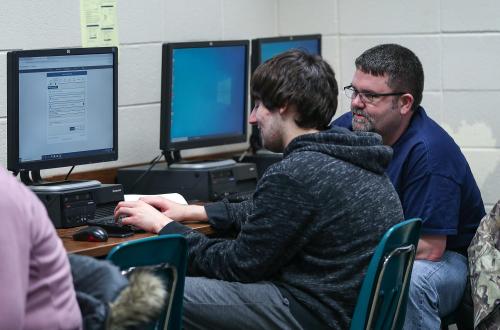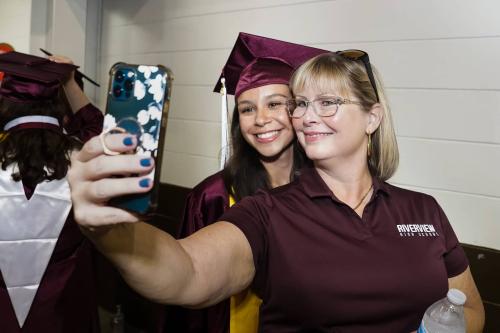For this year’s high school seniors, there is an important change to the process of applying for college financial aid. For the first time, students and their families can apply for aid by completing the Free Application for Federal Student Aid (FAFSA) in the fall rather than waiting until after the new year.
This change is a big deal.
Now, students and families will have more time to navigate the aid application process and the many steps that it entails. Currently, a substantial share of college students who are eligible for financial aid don’t successfully apply. This can occur because students never submit a FAFSA or, even if they do submit, they may fail to complete all the steps in the process.
Indeed, often-overlooked complexities can arise between when students submit the FAFSA and when they receive their financial aid offers from colleges. Some students miss simple steps like providing an electronic signature. Even among those who complete the FAFSA, many low-income students are required to verify the income and asset information they provide on their application. Students need to complete separate verification processes with each institution to which they have applied, and each institution has unique verification forms to complete. These additional steps in the financial aid process mean students may miss out on aid entirely, they may receive less than they are eligible for because they file after priority deadlines, or they may not receive aid until just weeks before the start of the fall semester. In prior work, we found that recent high school graduates’ college plans often were derailed by the fact that they were still trying to navigate the FAFSA process in the summer before college was to begin.
To better support students through the FAFSA maze from submission to completion, we designed and implemented a text-messaging campaign to address the informational and behavioral barriers associated with initial FAFSA filing. Crucially, our implementation partners had access to regularly updated student-level data on FAFSA filing status. For example, they knew whether a student had submitted or completed a FAFSA and additionally whether the student had been flagged for income verification. We capitalized on these data to provide students with regular, personalized outreach and updates on their FAFSA completion status. Students were able to write back for one-on-one, text-based assistance.
We implemented the intervention in two sites with two different research designs. In Texas, we partnered with eight school districts that together serve over 17,000 high school seniors to test the impact of the campaign using a school-level randomized control trial design. In Delaware, we partnered with state officials to offer the text-based outreach to all public high school seniors statewide.
In both sites, the text-based outreach improved FAFSA filing outcomes. In Delaware, rates of FAFSA completion were improved overall. In Texas, where we focused particularly on students who were college-intending, the text-based outreach led to earlier FAFSA filing and higher rates of college enrollment. Specifically, the outreach impacted immediate college matriculation by a statistically significant four percentage points.
Descriptive evidence from the National Post secondary Student Aid Survey reveals that among Texas students who do enroll in college, financial aid packages are more generous among those who file earlier. Thus, in our sample, filing earlier may have helped students to receive more generous financial aid packages and therefore to have more post secondary options truly open to them in terms of affordability when it came time to select a college.
“Thus, in our sample, filing earlier may have helped students to receive more generous financial aid packages and therefore to have more postsecondary options truly open to them in terms of affordability when it came time to select a college.”
Another finding bears particular attention. Among students in our Texas sample, a full 30 percent of FAFSA filers were flagged for income verification. To date, we have not seen verified data on the rate of selection for verification, so this figure itself is notable. Further, in our control schools, we found that among FAFSA filers, those selected for verification were 6 percentage points less likely to enroll in college. Importantly, we find suggestive evidence that our intervention helped to partially mitigate the detrimental effect of verification in treatment schools. Given that a substantial share of students is required to complete verification, moving up the FAFSA filing timeline affords students more time during the school year to navigate verification. Further, our work highlights the importance of drawing greater attention to FAFSA verification as a potential stumbling block to students receiving financial aid offers.
In our prior work on the derailment of students’ college plans in the summer after high school, we referred to this phenomenon as summer melt. Yet, a counselor whom we interviewed in this work cautioned that the “summer melt” label was a misnomer. Rather, the counselor argued that the melting process actually began in the winter, when students and families should be navigating the FAFSA. The impacts of our FAFSA intervention on timely enrollment, indeed, are similar in magnitude to those for analogous low-cost efforts to mitigate summer melt. Thus, our results lend credence to the notion that by supporting students with this key milestone, and shepherding them through the process earlier, rates of college access can be improved.
We call for federal, state, and local education agencies to do all that they can to help students take advantage of this additional time for financial aid application that the shift to relying on prior-prior-year tax information for filing has afforded. Indeed, based on our new findings, we see just how important the timing with which students navigate the FAFSA process can be.
Lindsay C. Page is an assistant professor of research methodology at the University of Pittsburgh School of Education and a research scientist at Pitt’s Learning Research and Development Center. Her work focuses on quantitative methods and their application to questions regarding the effectiveness of educational policies and programs across the pre-school to post secondary spectrum.
Ben Castleman is an assistant professor of education and public policy at the University of Virginia and a Fellow at the Behavioral Science and Policy Association. He is the author of The 160 Character Solution: How Text Messaging and Other Behavioral Strategies Can Improve Education, available from Johns Hopkins University Press.
Katharine Meyer is a PhD student in the Education Policy department at the University of Virginia, and a Virginia Education Science Training pre-doctoral fellow.









Commentary
The gift of time: The opportunity and benefit of early FAFSA filing
October 20, 2016